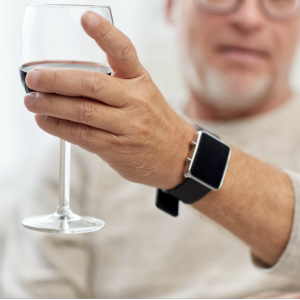Drinking And Aging: More Data On The Impact Of Alcohol

Drinking And Aging: More Data On The Impact Of Alcohol
March 9, 2022
Thinking about raising a glass to toast what may be the end of the pandemic (at least for now)? Before you take a sip, you may want to stop and read the latest findings about the impact of alcohol on the brain- it just may be enough to convince you that club soda is the way to go.
New research out of the University of Wisconsin and the University of Pennsylvania points to a conclusion that many will find difficult to swallow: Even following federal guidelines and only consuming one glass of alcohol per day could reduce your overall brain size over time- and the more you drink, the worse it is for brain health. According to the research, adults over age 50 drinking just one glass of wine or one pint of beer a day showed brain changes equivalent to 2 years of brain aging. Increasing that amount to 4 drinks produced the equivalent of 10 years of brain aging. So before you fill that last glass of the night, take a pause and read more here.
Of course, beyond the brain shrinkage that may be induced from alcohol consumption, there are other important reasons why older adults need to think carefully about whether to drink and in what quantity. According to a recent article published by AARP, as we get older we process alcohol differently, leaving us with different and at times more intense effects from alcohol consumption. For example, older bodies may have less water, so alcohol is less diluted resulting in a higher blood-alcohol content. Moreover, your older body produces less of the enzyme necessary to digest alcohol so that it stays in your system longer. You may also not be aware of your alcohol intolerance as you get older, leaving you more at risk for falling if you don’t perceive your balance is hindered or your perceptions are skewed.
Alcohol also worsens many of the medical conditions that afflict older adults, including certain cancers, blood pressure, along with the risk of stroke and immune system disorders. As well, according to Medshadow.org, beer, wine, and hard liquor can exacerbate the effects of many medications, creating dangerous or even life-threatening complications as a result of mixing medications with alcohol. The National Institute on Alcohol Abuse and Alcoholism lists more than 100 drugs that can cause harm if mixed in your system with alcohol. Even mixing a drink with such common medications as blood pressure meds, cholesterol-lowering meds, or over-the-counter NSAIDs like ibuprofen or naproxen can not only lead to stomach distress but can create life-threatening liver damage.
So is there any good news to report when it comes to drinking alcohol? There is one new study grabbing headlines regarding the relationship between drinking wine during a meal and the risk of type 2 diabetes. According to this not-yet-published study, drinking moderate amounts of wine (though not other forms of alcohol) with a meal is associated with a 14% lower risk of developing type 2 diabetes. This reduction occurred only when the wine was consumed with a meal, not when it was consumed alone. However, it’s not clear that it’s the alcohol content in the wine that makes a difference. Rather, it may be the antioxidants at play in the wine that cause this risk reduction. For more on this study, grab your corkscrew and click here. And if you’re thinking that red wine at least has more healthy qualities than white, you may need to think again. In fact, there’s little evidence to support that notion. To find out more, read here.







